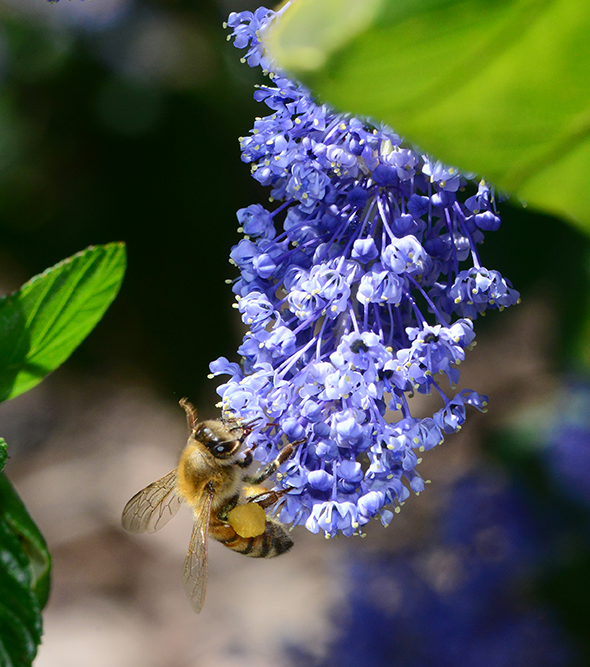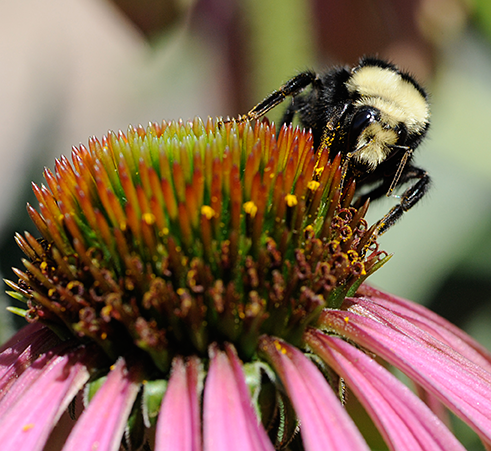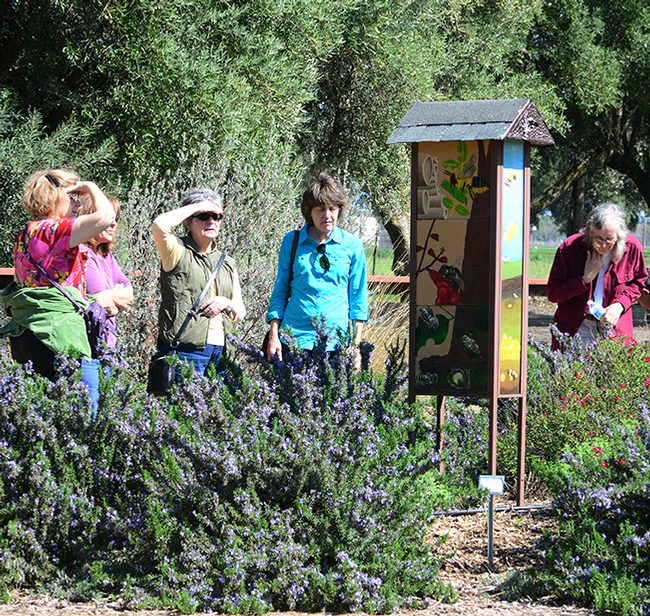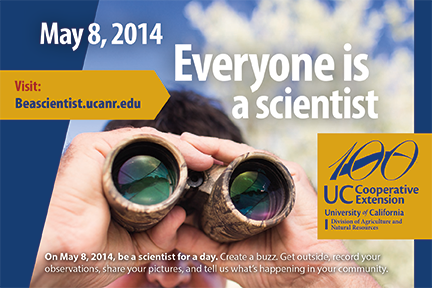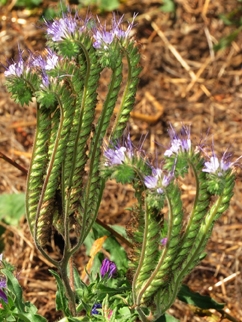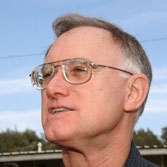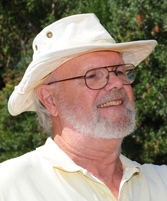Posts Tagged: pollinators
Where the Bees Are
Do you now where the bees are? On Thursday, May 8 let's all step outside for three minutes and count the honey bees and other...
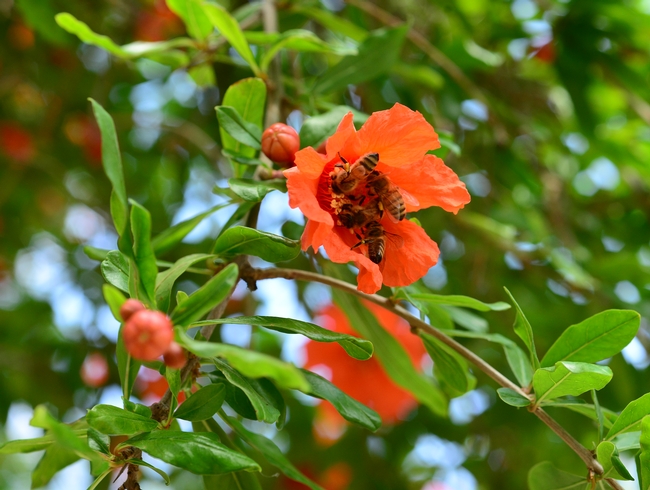
Honey bees clustering on pomegranate blossom. (Photo by Kathy Keatley Garvey)
Pollinators in trouble
On April 30, Barbara Allen-Diaz, vice president of the UC Division of Agriculture and Natural Resources, will wear bees – live honeybees. The event is a fundraiser for undergraduate education, and Allen-Diaz, who has endured bee stings in the past, is willing to take the risk for this important cause. She'll have the help of a noted bee wrangler, UC Davis emeritus professor of entomology Norm Gary. Gary has performed such unlikely stunts as playing the clarinet while covered with honeybees. He will apply a synthetic pheromone to Allen-Diaz's hands to attract the bees, which he says are unlikely to sting unless provoked.
“I'll be holding a precious resource in my hands, one that is essential to life on earth,” says Allen-Diaz. “I'll be placing my hands in Norm's hands to raise awareness about the value of honeybees.”
While raising money for education is certainly a worthy goal, as Allen-Diaz says, the event also draws attention to the plight of our most important agricultural pollinator. In 2006, a number of beekeepers in the Western U.S. noticed their hives had lost 30 to 70 percent of their worker bees. The phenomenon, now known as colony collapse disorder (CCD), is still not fully understood, though a number of factors are believed to be involved. They include habitat loss or degradation and fragmentation, poor nutrition, certain bee management and agricultural practices, natural and chemical toxins, diseases, and parasites. Any one of these factors can affect the insects' ability to combat any of the others. Isolating a single cause, if there is one, has proved elusive.
Many of the fruits and vegetables on the tables of the world are pollinated by insects, particularly bees, and if they were to disappear, our sources of plant food would be restricted to grains and not too much else. It's no wonder CCD is such a concern (for example, see the United Nations Environmental Program 2010 report on Global Bee Colony Disorder and USDA, Honey Bees and Colony Collapse Disorder.
It's not just honeybees, either. Pollinators in general are on the decline worldwide, probably for many of the same reasons that are listed as factors in CCD. They have an essential ecological function on every continent except Antarctica, not merely in service to agriculture. Losey and Vaughn (2006) estimate the value to the U.S. economy of native insects (not honeybees, which are native to Europe) to be at least $57 billion.
As human population grows and becomes more urban, and as habitats get more fragmented, it is no longer adequate to focus conservation efforts merely in non-urban, non-working landscapes.
“We need to figure out how to accommodate as many native species as possible in these kinds of places,” says Patrick Huber of the City of Davis Open Space and Habitat Commission, which has adopted pollinator habitat enhancement as a working goal. The Commission is working to compile a GIS dataset of known big patches of habitat in Davis, in order map pollinator resources around town.
Huber is a geographer in the Landscape Analysis and Systems Research lab at UC Davis, where he focuses on spatial scale in conservation planning. He is working on a tool to help match gardeners with plants that will grow well in their regions, that are locally available, and that provide a network of resources for pollinators throughout the urban landscape and on into the agricultural landscape. For the moment this project is being piloted in Davis, but the hope is to expand it to other communities, tying in resources such as CalFlora.
A recent workshop at UC Davis sponsored by the California Center for Urban Horticulture, Your Sustainable Backyard: Pollinator Gardening, focused on this very issue: what gardeners can do to help pollinators, many of which are bees. (Of 19,500 known bee species in the world, 4,000 can be found in North America and 1,600 in California. There are at least 300 species of bee in Yolo County alone.) Urban gardeners can help pollinators by:
- Planning for succession blooming (in the Central Valley, that means late winter through fall)
- Putting plants in clumps at least 4 feet long if possible (honeybees, especially, like to specialize)
- Putting in plants that provide both nectar and pollen (nectar is fuel for adult bees, pollen is protein for the young)
- Using native plants where possible; they're drought tolerant and have what our native bees need
- Avoiding most-toxic pesticides and herbicides
- Providing a clean source of water (a slow-dripping tap on a sloped surface is ideal; bees like to drink from very shallow sources)
- Providing cavity nest holes in wood for carpenter and other bees
- Leaving some areas of gardens unmulched for ground-nesting bees
There are ways the agricultural landscape can be made more hospitable, too. Neal Williams, professor of entomology at UC Davis, has been working on a project to install 600- to 800-meter plots of flowering plants alongside large fields as resources for pollinators. This has moved out of the trial phase into test plots in coastal and foothill areas as well as in the Central Valley.
Meanwhile, we can all help count our pollinators on May 8, the Day of Science and Service to celebrate 100 years of Cooperative Extension in California. We'll be conducting our own pollinator count here outside the ANR building in Davis: join us, or let us know about yours!
Many thanks to Kathy Keatley Garvey for use of her photos.
Attracting Pollinators to Your Garden
"How to Attract and Maintain Pollinators in Your Garden." That's the title of a new publication by the University of California Agriculture and...
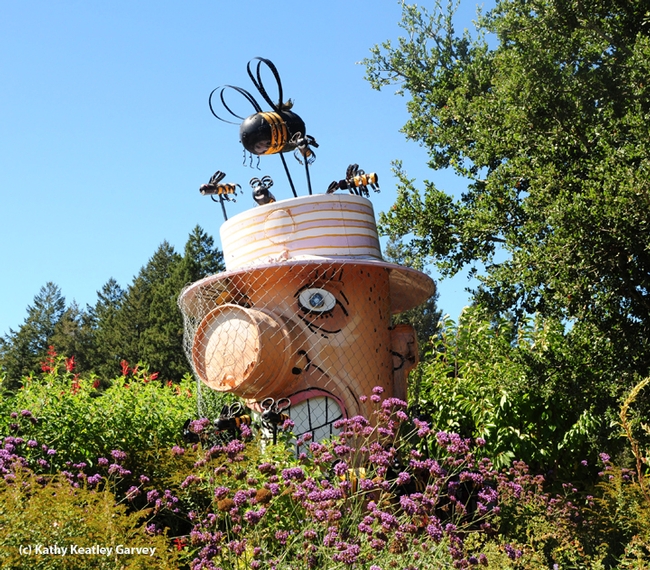
A sculpture of Bernard the Beekeeper graces the entrance to Melissa's Garden, Healdsburg. (Photo by Kathy Keatley Garvey)
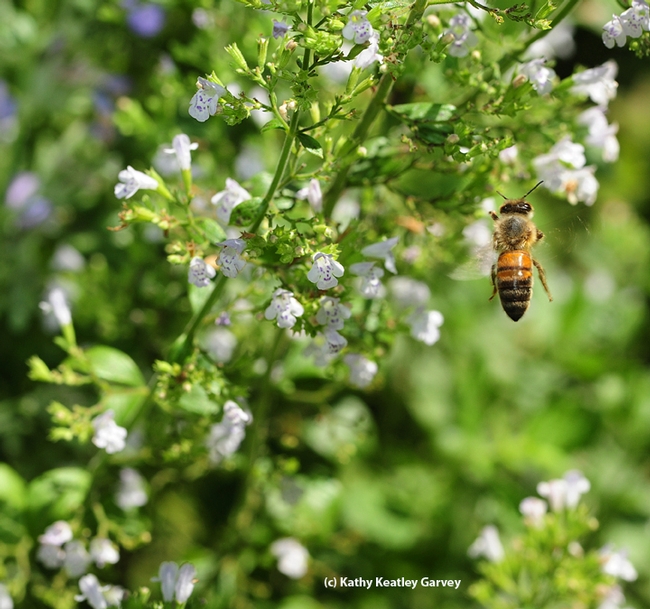
A honey bee foraging in Melissa's Garden. (Photo by Kathy Keatley Garvey)
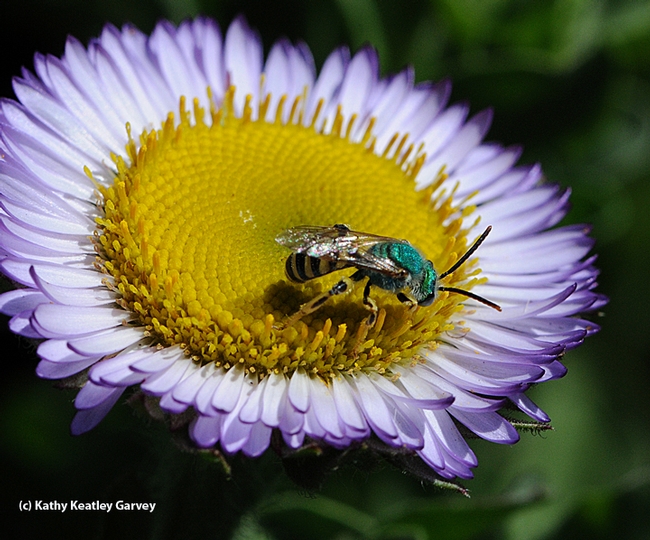
A metallic green sweat bee on a seaside daisy. It is one of some 1600 species of bees in California. (Photo by Kathy Keatley Garvey)
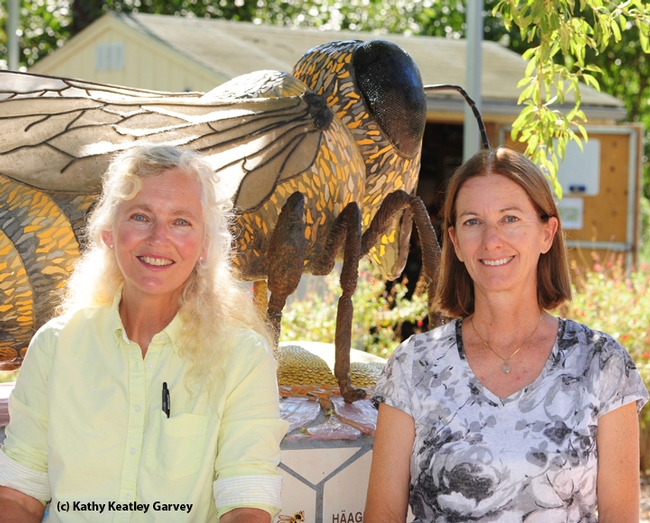
International landscape designer Kate Frey (left) of Hopland and her childhood friend, Rachael Long, Yolo County farm advisor/county director of the UC Cooperative Extension, Woodland on a visit to the Haagen-Dazs Honey Bee Haven, UC Davis, in September. Behind them is the mosaic ceramic bee sculpture created by Donna Billick, co-director of the UC Davis Art/Science Fusion Program. (Photo by Kathy Keatley Garvey)
Honey bees: Should they be banned from native plant restoration areas?
What’s a honey bee to do?
The dwindling resources of pollen and nectar-producing plants in California greatly concern bee scientists and beekeepers, and rightfully so.
But the dwindling resources also greatly concern native pollinator specialists and native plant enthusiasts. Some worry that honey bees, which are non-natives, may be "reducing" or "eliminating" native pollinators through competition for food.
Are they?
Extension apiculturist Eric Mussen of the UC Davis Department of Entomology and Nematology explains that a number of agencies and organizations are cooperating in an effort to "restore" regions of the California Central Valley to their "original state."
“The major emphases are (1) replacing non-native vegetation with native plants and (2) encouraging native animals to return to their former ranges,” Mussen says. "The result has been eviction of beekeepers from apiary locations that have been used for decades as seasonal spots for rebuilding populations following the stresses of commercial pollination or for producing honey."
“While removing this non-native pollinator from an environment may sound rational at first, it may not be the best idea,” Mussen points out. “In most cases, it is not the presence of honey bees that has depressed or eliminated the populations of native pollinators. In fact, no studies have shown that honey bees eliminate native pollinators. In some cases, the populations of native pollinators have been reduced by honey bee competition, but following removal of honey bees the native bees built back to usual levels in a couple years.”
Indeed, in some situations, honey bees can survive, and native pollinators can’t.
“With honey bees, if we provide them with an adequate hive and food sources, they are likely to survive,” Mussen says. “However, native pollinators can be very particular about the environment in which they can exist. If their nesting habitat is disturbed, modified or destroyed, they cannot live in the area, despite an abundance of food plants. In many California locations, it is habitat alteration or destruction, not lack of food, which eliminated the native pollinators.”
When native habitats are compromised, “honey bees may be essential to foster initial re-establishment of native plant populations,” Mussen relates. “Those plants provide food and shelter for wildlife and assist significantly in erosion control. Until the habitat is restored adequately to meet the requirements of native pollinators, it is likely that the presence of honey bees will be much more beneficial than detrimental in keeping the California native plants pollinated and reproducing.”
So, should honey bees be banned from restoration areas?
"No," Mussen says. "Honey bees should be solicited for restoration areas, not banned."
Mussen shares a list of 130 native California plants that are likely to be visited - "and probably pollinated" - by honey bees. They include button bush or button willow, fiddleneck, and California golden poppy. The list is excerpted from Nectar and Pollen Plants of California by G. H. Vansell UC Berkeley, plus personal observations by native pollinator specialist Robbin Thorp, UC Davis emeritus professor of entomology. The list is updated, reflecting information on the CalFlora website and the Jepson Manual of Higher Plants of California.
Thorp, who monitors the Häagen-Dazs Honey Bee Haven, planted in the fall of 2009 on Bee Biology Road, UC Davis, has found more than 80 different species of bees - and counting - in the half-acre bee garden. It's located next to the apiary at the Harry H. Laidlaw Jr. Honey Bee Research Facility.
So honey bees and native bees share the resources.
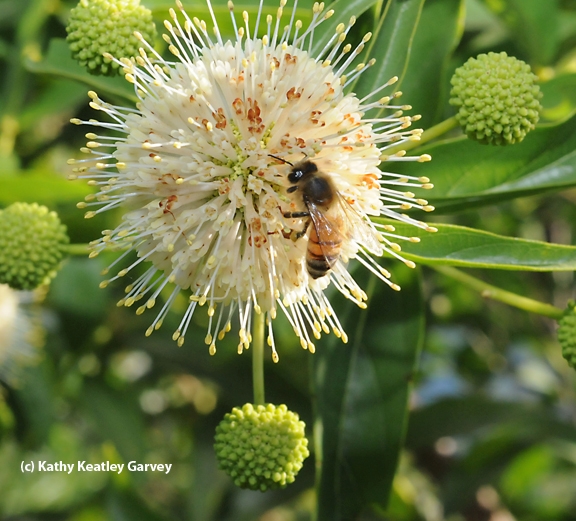
A honey bee foraging on button willow, also known as button bush, Cephalanthus occidentalis. Honey bees on non-natives, and the button bush is a native California plant. (Photo by Kathy Keatley Garvey)
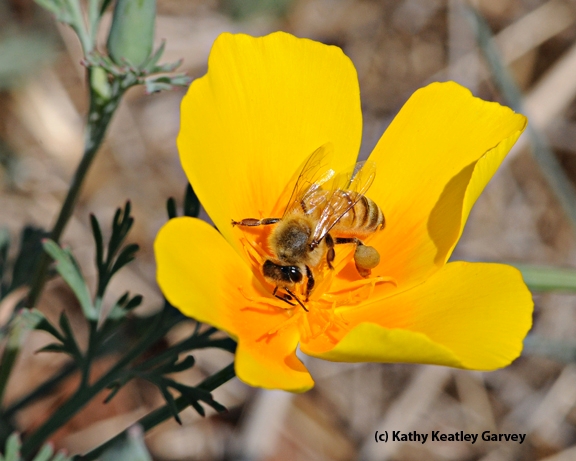
Honey bee visiting California golden poppy, Eschscholzia spp. (Photo by Kathy Keatley Garvey)
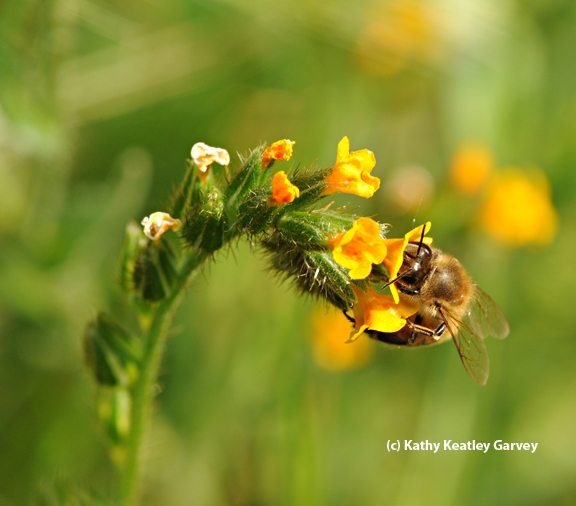
Honey bee foraging on fiddleneck, Amsinckia spp. (Photo by Kathy Keatley Garvey)
For Beginners, a Guide to Pollinators
So many flowers. So many pollinators. So many floral visitors. On every field trip, we see something new and different, such as the male...
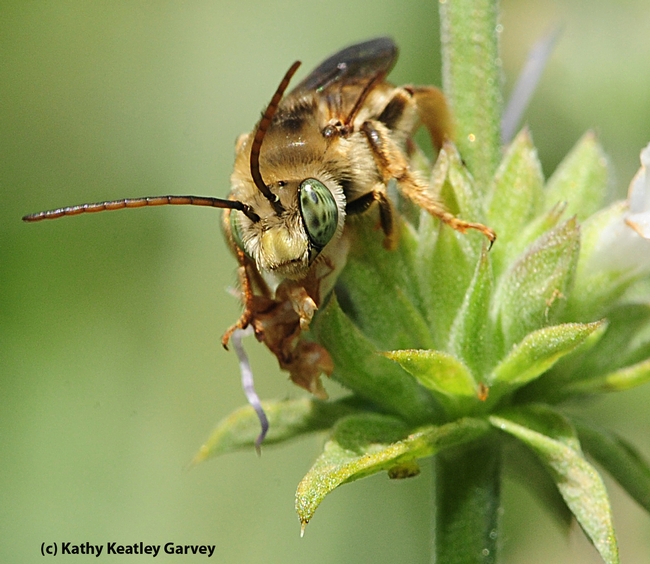
Male long-horned bee, Melissodes communis, on salvia. Identified by Robbin Thorp. (Photo by Kathy Keatley Garvey)
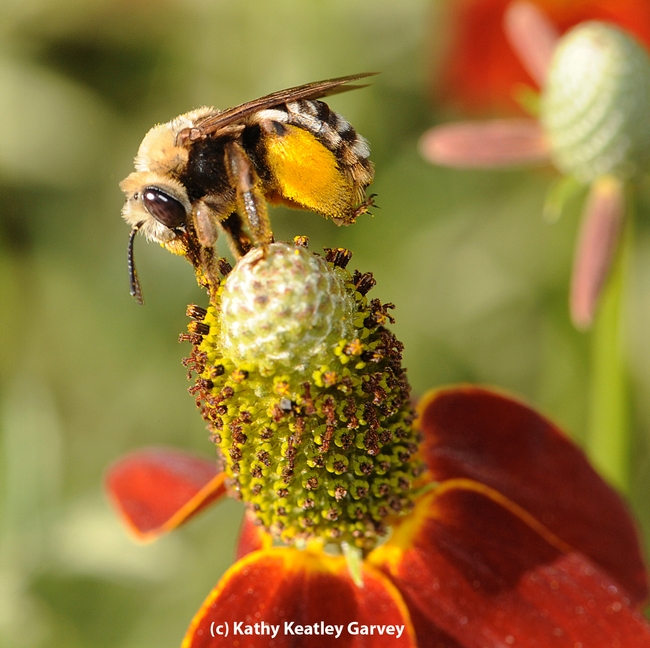
Female sunflower bee, Svastra obliqua expurgata, on Mexican hat flower. Identified by Robbin Thorp. (Photo by Kathy Keatley Garvey)


